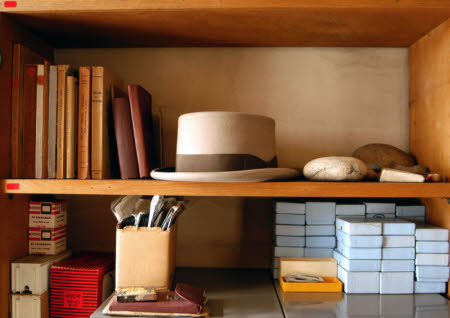This blog continues in the “Europe & the U.S. in 99 Objects” series. Dr. Gabriella de la Rosa at the National Trust has started this project for the National Trust, originally published here, by delving into the Trust’s collections – nearly 1 million objects held at over 200 historic properties across the United Kingdom – to find objects with interesting, unusual and unexpected connections to Europe. These objects and their stories are being published in the form of a digital diary on the National Trust Collections website.
#6 Top hat
Symbolically displayed above Ernö Goldfinger’s desk at 2 Willow Road, Hampstead is the hat of his architectural mentor Auguste Perret. It was Perret who introduced the Austro-Hungarian émigré architect to reinforced concrete. The material became synonymous with architectural Modernism across continental Europe in the 1920s and 30s and decades later in the Brutalist tower blocks Goldfinger designed in London.
But 2 Willow Road is no high-rise hell. Very little concrete is exposed in this 2-story terraced house that Goldfinger built for himself and his family. Willow Road’s unique and influential design, complete with purpose-built furniture and fittings, provides a glimpse of Modernist living amidst the migration of artistic souls from war-torn Europe to the particularly creative nest that was Hampstead at the time.
Goldfinger was a notorious bully and given to fits of rage which prompted Ian Fleming to name James Bond’s megalomaniac adversary after him in his 1959 novel and the film which followed. An incensed Goldfinger threatened to sue and Fleming retaliated by suggesting to his publishers that the name be changed to ‘Goldprick’. They didn’t oblige this request and in so doing, Goldfinger entered into cinematic folklore. He’s now remembered as much as a fictitious villain as a visionary architect.
Category :Costume
Date: 1900 – 1950
Materials: Felt Leather Ribbon
Measurements: 138 x 257 x 306 mm
Collection: 2 Willow Road, London (Accredited Museum)
On show at: 2 Willow Road, London, London and South East, National Trust
NT 112836
#7 Memorial plaque
Category: Metalwork
Date: 1649
Materials: Brass
Collection: Ham House, Surrey (Accredited Museum)
On show at: Not on show
NT 1139995
Modern Britons have complained vigorously about how European Union regulations often act as a restraint on trade. But don’t imagine we haven’t been up to it ourselves for a good few centuries.
In 1666, the year of the Great Fire, Charles II signed an Act of Parliament requiring all coffins to be lined with no other textile than wool and for the corpses to be also dressed in wool only and certainly not ‘Flax Hempe, Silk, Haire, Gold or Silver.’ Fine a hefty £5 for offenders.
Why? Well, it was clearly a useful boost to the wool industry – one of the country’s most important products – then suffering a recession. One exception was made. ‘Persons dying of the Plague’ – and this was one year after the Great Plague had devastated London – were obliged to be buried in ‘linnen’.Presumably, this was a sanitary measure and good news, one assumes, for the Irish linen industry.
This plate is from the coffin of the heiress Elizabeth Dysart of Ham House’s mother. Records show that both Elizabeth and her sister Mary were both buried in linen and their family fined the requisite fivers for the offence – a sum that no doubt they could afford.






